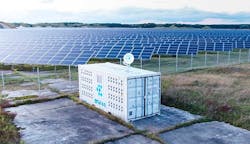Make no mistake. Cryptocurrencies will be greener. It is inevitable.
There are a number of promising initiatives underway to improve the energy profile of Bitcoin and other cryptocurrencies and accelerate the shift to a sustainable blockchain sector. These include more use of renewable energy, but also a range of other initiatives to embrace more energy-efficient protocols, carbon offsets, demand response and greener mining pools.
The past week’s selloff in the cryptocurrency markets has focused attention on Bitcoin’s energy usage, and its reliance on fossil fuels for the mining operations that secure its blockchain operations. A recent study by Cambridge University found that about 39 percent of the Bitcoin network is powered by renewable energy. This is an international challenge, as the U.S. represents about 7 percent of the global hashrate, compared to 65 percent for China.
At the industry level, about 40 projects have expressed support for the Crypto Climate Accord, a private sector initiative to decarbonize the cryptocurrency sector by making it easier for blockchain projects to purchase offsets. Participants include Argo Blockchain, Hut8 Mining and the Ripple project, but none of the marquee players in crypto as yet.
“As more data continues to surface regarding Bitcoin and Bitcoin mining’s impact on the environment, it’s imperative that the industry takes real, tangible action,” said Peter Wall, CEO of Argo Blockchain. “The Crypto Climate Accord helps lay the groundwork for that action and we are both eager and determined to ensure that supporters and signatories remain committed to the CCA’s goals.”
There’s also the Bitcoin Clean Energy Investment Initiative, which was founded by Square to support companies that help drive adoption and efficiency of renewables within the bitcoin ecosystem. Square has committed $10 million to the effort, which recently featured the release of a white paper titled “Bitcoin is the Key to an Abundant, Clean Energy Future.”
“We believe that cryptocurrency will eventually be powered completely by clean power, eliminating its carbon footprint and driving adoption of renewables globally,” said Square CEO and co-founder Jack Dorsey. “Published estimates indicate bitcoin already consumes a significant amount of clean energy, and we hope that Square’s investment initiative will accelerate this conversion to renewable energy.”
Now let’s look at some of the initiatives by companies and projects in the cryptocurrency sector.
Ethereum Shifts to Proof-of-Stake
Ethereum is the second-largest cryptocurrency by market capitalization, and the primary platform for DeFi (decentralized finance) and NFTs (non-fungible tokens), two potentially transformative technologies that are seeing huge investment interest. Ethereum is currently supported by a “proof-of-work” mining system similar to bitcoin, but has begun a transition to proof-of-stake, an approach that will dramatically reduce the energy impact of Ethereum.
The Ethereum Foundation said last week that the proof-of-stake upgrade will slash the Ethereum blockchain’s energy use by 99.95 percent, with the potential to operate the entire blockchain on about 2.6 megawatts of energy.
“Ethereum’s power-hungry days are numbered, and I hope that’s true for the rest of the industry too,” said Carl Beekhuizen, a researcher at the Ethereum Foundation. The transition is expected to happen by the end of 2021.
Other tokens in the DeFi ecosystem have already adopted proof-of-stake, including Algorand, which says it will be the world’s first climate negative cryptocurrency. Other widely-held proof-of-stake coins include Cardano, EOS and TRON.
Some more ambitious eco-coin efforts have had to rethink their plans. SolarCoin is a cryptocurrency issued to users of solar power, who earn coins by validating their usage. SolarCoin recently decided to shift to running atop Ethereum.
Renewably-Powered Mining Operations
Bitcoin’s sustainability challenge presents an opportunity for North American miners, who can adapt their model to create earth-friendly mining operations that align with the compliance requirements and ESG mandates of stakeholders in business and finance. One of the leading players in this effort has been Foundry Digital. which provides capital to mining operations to buy mining hardware and infrastructure to help build a stronger presence in the U.S. and Canada.
Foundry is a unit of Digital Currency Group, the cryptocurrency conglomerate that staked the effort with a $100 million investment. Foundry has helped to procure nearly half of the Bitcoin mining machines installed in North America in 2020, and has worked with Core Scientific, Bitfarms, Bit Digital and Compute North.
“We want to empower decentralized infrastructure in the new digital economy, and our work will support the development and growth of mining operations – particularly in North America,” said Mike Colyer, CEO of Foundry.
In North America, much of the sustainable mining capacity is in Quebec, where hydro power provides most of its energy. Bitfarms has five industrial-scale mining facilities in Québec, which are 100% powered with hydro electricity via long-term power contracts. Argo has just acquired two data centers in Quebec that are supported by hydro power.
Argo is also sourcing renewable energy for its huge and growing mining operation in West Texas, where it has acquired 320 acres of land and plans to build a 200-megawatt mining facility over the next 12 months, with “the majority” of that energy will come from renewable sources.
Mechanical Technology Inc. has announced EcoChain, a mining operation supported by renewable energy. It has partnered with renewable energy specialist Soluna to launch its operations with a 2.6-megawatt operation in Wenatchee, Washington, where MTI acquired mining assets from Gigawatt. MTI has bought additional land in the Southeastern U.S. and plans to scale to 50 MW of renewable mining by the end of 2021.
Blockchain-Powered Carbon Offsets
This week two leading cryptocurrency exchanges, FTX and BitMex, announced plans to become carbon neutral by purchasing carbon credits.
“FTX is going carbon neutral, donating $1m to offset the blockchain resources it uses,” tweeted Sam Bankman-Fried, the CEO of FTX. “So we can make the world greener, and so we can keep pushing crypto forward.”
Cryptocurrency mining rigs inside a facility operated by DMG Blockchain. (Photo: DMG Blockchain)
“Carbon offsetting is not the only answer to concerns relating to the environmental footprint of crypto, but it’s certainly a good start,” BitMex said in a blog post. “We believe that crypto is a huge force for good in the world, but the industry has to come together and tackle challenges that risk sidetracking our positive intentions.”
Several crypto platforms are using blockchains to facilitate these efforts.
The Energy Web Chain is an enterprise blockchain for utilities that has created a carbon offset marketplace, and also helped organize the Crypto Climate Accord. Ripple, which supports the Tether stablecoin, worked with EnergyWeb to create EW Zero, an open-source tool that will enable any blockchain to decarbonize through the purchase of renewable energy in local markets worldwide. As part of its effort, Ripple is committing to achieve carbon net-zero by 2030.
“As digital payments continue to evolve, we need to make long-term systemic shifts as an industry to ensure digital transformation doesn’t come at the cost of our planet,” says Brad Garlinghouse, CEO of Ripple. “We are leading this change and urging all crypto players to hold themselves accountable – monitoring their energy consumption to make greener choices.”
Climate Trade is another marketplace for carbon offset. It runs on Algorand, and is helping that blockchain meet its goal of being carbon-negative. Algorand and ClimateTrade will implement a sustainability oracle which will track Algorand’s carbon footprint and acquire an equivalent amount of carbon credits in a “green treasury” to keep the protocol running as carbon-negative. In cryptocurrency, oracles are services that help blockchains integrate off-chain data.
Greener Options for Pools:
Mining pools are groups of miners that combine their computational power to improve their chance of earning block rewards. DMG Blockchain Solutions and Argo Blockchain recently announced Terrapool, calling it the world’s first Bitcoin mining pool powered by clean energy. Initially, the pool will use hashrate from DMG and Argo that runs on energy generated by hydroelectric resources. Going forward, the partners will invite “like-minded miners” to join the pool.
“DMG’s continued focus on eco-friendly Bitcoin mining has the opportunity to drive transformations in how the Bitcoin mining community acts towards a climate-conscious future,” said DMG CEO Dan Reitzik. “We believe this is an opportunity for continued growth as we develop a better understanding of climate-friendly operations while simultaneously integrating the newest and most innovative blockchain technologies.”
Demand Response
A Compute North modular data center housing bitcoin mining infrastructure. (Photo: Compute North)
Blockchain colocation specialist Compute North recently entered into demand response programs with its energy suppliers, allowing its use of grid energy may be rapidly curtailed to dispatch power to mission critical customers, such as hospitals. Compute North Chairman and co-founder PJ Lee said the company’s infrastructure provides “the flexibility to throttle power demand at each facility as required, making it a critical partner to the overall stability of local power grids as they bring more renewables online.”
The demand response program helped Compute North win a 40-megawatt deal to host operations for Bit Digital, a publicly-held mining firm.
“Bit Digital is focused on growing our mining operations, while selecting strategic partners that enable the transition to sustainable bitcoin mining,” said Bryan Bullett, CEO at Bit Digital. “On the energy supply side, we are evaluating new renewable sources to complement our existing renewables-based mining. On the demand side, we are embracing demand response programs like Compute North’s. We refer to this as “Mining 2.0” – a multi-pronged strategy to activate our ability to dynamically manage power usage, both to manage costs, and to accelerate adoption of renewable energy sources for mining, and for the grid generally.”
Dogecoin? Really?
The joke-born, meme-powered Dogecoin cryptocurrency uses the Scrypt algorithm, a less energy-intensive approach also used with Litecoin. As a result, Dogecoin is estimated to require just 0.1 kWh of electricity per transaction, compared to an estimated 650 kWh for bitcoin.
Musk has been a huge booster of Dogecoin, and SpaceX has accepted payment in Dogecoin for the DOGE-1 moon mission. There are growing hints that Tesla will soon embrace Dogecoin in a more serious way, as Musk has foreshadowed on his Tweets. “Low fees and high volume are needed to become currency of Earth,” he Tweeted Sunday, responding to data on Dogecoin’s transaction throughput.






